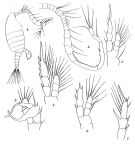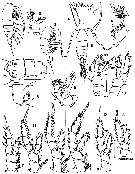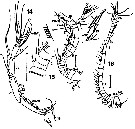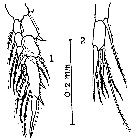|
|
 |
Fiche d'espèce de Copépode |
|
|
Calanoida ( Ordre ) |
|
|
|
Diaptomoidea ( Superfamille ) |
|
|
|
Centropagidae ( Famille ) |
|
|
|
Centropages ( Genre ) |
|
|
| |
Centropages alcocki Sewell, 1912 (F,M) | |
| | | | | | | Ref.: | | | Sewell, 1912 (p.338, figs.F,M); Kasturirangan, 1963 (p.32, figs.M); Vervoort, 1964 b (p.309); Saraswathy, 1966 (1967) (p.78, figs.F, Rem.); Wellershaus, 1970 (p.464, figs.F,M); Silas, 1972 (p.648); Connell, 1981 (p.497, Rem.); Ohtsuka & Nishida, 2017 (p.575, Rem.) |  issued from : Sewell R.B.S. in Rec. Indian Mus., 1912, 7. [Plate XVII, Figs.1-7]. Male (from Bay of bengal): 1, habitus (lateral view); 2, A1; 3, P1; 4, P2; 5, P5 (right side); 6, P5 (left side). Nota: Head and 1st thoracic segment separate, 4th and 5th separate. Grasping of right A1 has the knee-joint between the 18th and 19th segments; 10th, 11th and 12th segments all bear a curved spine-like process on the anterior surface, 17th segment bears a toothed-plate which is somewhat longer than the segment itself and is prolonged over the proximal part of the 18th segment; 19 th segment bears teeth the whole length of the segment and is then produced as a spinous process beyond the distal extremity. Female: 7, P5. Nota: Head and 1st thoracic segment separate, 4th and 5th separate; the posterior border of the last segment is rounded and near the ventral border presents a short backwardly directed spinous process. Rostrum small and bifid. Abdomen 3-segmented, symmetrical; Proportional lengths of urosomites and furca as 35:23:20:15; the 1st segment bears on each side a clump of small needle-shaped spines. A1 (24-segmented) do not reach to the end of the thorax; there are no spines on any of the proximal segments.
|
 issued from : S. Wellershaus in Veröff. Inst. Meeresforsch. Bremerh., 1970, 12. [p. 465, Figs. 1-13]. Male (from Cochin Backwater, S. India): 3, habitus (lateral view, right side); 5, idem (dorsal view); 10, P5 (posterior aspect); 14, right A1 (segments 19-21, ventral aspect); 15, right A1 (dorsal aspect). Female: 1, habitus (lateral, right side); 2, Md (mandibular palp); 4, Md (masticatory edge); 6, Mxp; 7, thoracic segment 5 and urosome (lateral, left side); 8, distal part of thoracic segment 5 and genital complex (lateral, right side); 9, A2; 11, P1- P4 (posterior aspect); 12, right P5 (posterior aspect; left leg is alike). Copepodit V female: 13, right P5 (posterior aspect; left leg is alike).
Scale : single line = 0.1 mm ; double line = 0.05 mm.
|
 issued from : S. Wellershaus in Veröff. Inst. Meeresforsch. Bremerh., 1970, 12. [p.468, Figs. 14-16]. Male: 14, right A1 (segments 19-21; ventral aspect); 15, right A1 (with details, not all setae drawn; dorsal aspect). Female: 16, right A1.
|
 issued from : M. Saraswathy in Proc. Symp. Crustacea.- Symp. Ser. mar. biol. Ass. India, 1966, 2 (1). [p.82, Fig.1 (1-2)]. Female (from Trivandrum coast, SW India): 1, P5; 2, ultimate segment of A2. Nota: Sewell figures the inner spines on the 2nd exopod segment of female P5 without any spines. But in the present specimens there are 2 rows of minute teeth. The ultimate segment of A1 is provided with a thick spine-like process and a few setae (as in C. trispinosus), but this is not shown in Sewell's illustration.
| | | | | Ref. compl.: | | | Sewell, 1932 (p.228); 1948 (p.323); Patel, 1975 (p.659); Madhupratap & Haridas, 1986 (p.105, tab.1); Madhupratap & al., 1996 (p.866); Ramaiah & al., 1996 (p.3); Achuthankutty & al., 1998 (p.1, Table 2, seasonal abundance vs monsoon); Madhu & al., 2007 (p.54, Table 4, abundance vs monsoon); Fernandes, 2008 (p.465, Tabl.2) | | | | NZ: | 1 | | |
|
Carte de distribution de Centropages alcocki par zones géographiques
|
| | | | | | | Loc: | | | India, Goa, Saurashtra coast, Burhabalanga estuary, Kerala, Rangoon (estuairy), Gulf of Oman, Arabian Sea, Bay of Bengal | | | | N: | 11 (N Indian : 11) | | | | Lg.: | | | (81) F: 1,2; M: 1,1; (334) F: 1,4-1,1; M: 1,2-1; (349) F: 1,35-1,16; M: 1,1-1,05; (530) F: 1,1; M: 1; {F: 1,10-1,40; M: 1,00-1,20} | | | | Rem.: | Saumâtre. Proche de C. natalensis.
Voir aussi les remarques en anglais | | | Dernière mise à jour : 11/05/2019 | |
|
|
 Toute utilisation de ce site pour une publication sera mentionnée avec la référence suivante : Toute utilisation de ce site pour une publication sera mentionnée avec la référence suivante :
Razouls C., Desreumaux N., Kouwenberg J. et de Bovée F., 2005-2025. - Biodiversité des Copépodes planctoniques marins (morphologie, répartition géographique et données biologiques). Sorbonne Université, CNRS. Disponible sur http://copepodes.obs-banyuls.fr [Accédé le 24 décembre 2025] © copyright 2005-2025 Sorbonne Université, CNRS
|
|
 |
 |







